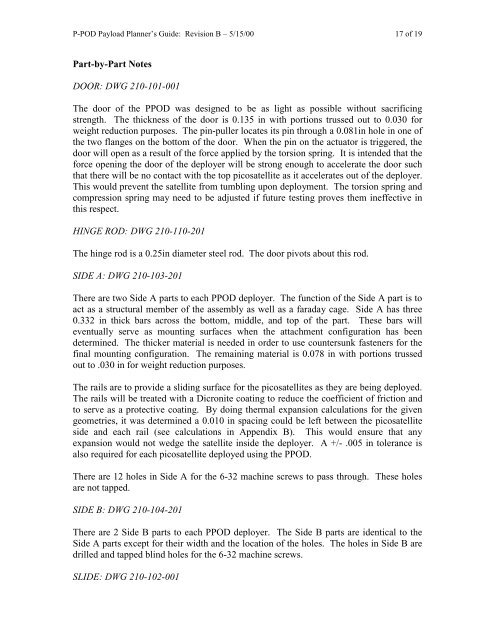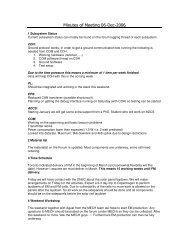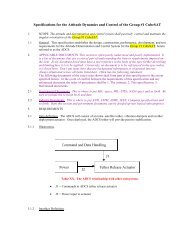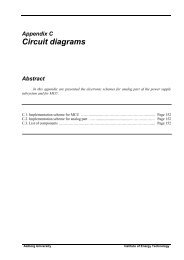The P-POD Payload Planner's Guide
The P-POD Payload Planner's Guide
The P-POD Payload Planner's Guide
You also want an ePaper? Increase the reach of your titles
YUMPU automatically turns print PDFs into web optimized ePapers that Google loves.
P-<strong>POD</strong> <strong>Payload</strong> Planner’s <strong>Guide</strong>: Revision B – 5/15/00 17 of 19<br />
Part-by-Part Notes<br />
DOOR: DWG 210-101-001<br />
<strong>The</strong> door of the P<strong>POD</strong> was designed to be as light as possible without sacrificing<br />
strength. <strong>The</strong> thickness of the door is 0.135 in with portions trussed out to 0.030 for<br />
weight reduction purposes. <strong>The</strong> pin-puller locates its pin through a 0.081in hole in one of<br />
the two flanges on the bottom of the door. When the pin on the actuator is triggered, the<br />
door will open as a result of the force applied by the torsion spring. It is intended that the<br />
force opening the door of the deployer will be strong enough to accelerate the door such<br />
that there will be no contact with the top picosatellite as it accelerates out of the deployer.<br />
This would prevent the satellite from tumbling upon deployment. <strong>The</strong> torsion spring and<br />
compression spring may need to be adjusted if future testing proves them ineffective in<br />
this respect.<br />
HINGE ROD: DWG 210-110-201<br />
<strong>The</strong> hinge rod is a 0.25in diameter steel rod. <strong>The</strong> door pivots about this rod.<br />
SIDE A: DWG 210-103-201<br />
<strong>The</strong>re are two Side A parts to each P<strong>POD</strong> deployer. <strong>The</strong> function of the Side A part is to<br />
act as a structural member of the assembly as well as a faraday cage. Side A has three<br />
0.332 in thick bars across the bottom, middle, and top of the part. <strong>The</strong>se bars will<br />
eventually serve as mounting surfaces when the attachment configuration has been<br />
determined. <strong>The</strong> thicker material is needed in order to use countersunk fasteners for the<br />
final mounting configuration. <strong>The</strong> remaining material is 0.078 in with portions trussed<br />
out to .030 in for weight reduction purposes.<br />
<strong>The</strong> rails are to provide a sliding surface for the picosatellites as they are being deployed.<br />
<strong>The</strong> rails will be treated with a Dicronite coating to reduce the coefficient of friction and<br />
to serve as a protective coating. By doing thermal expansion calculations for the given<br />
geometries, it was determined a 0.010 in spacing could be left between the picosatellite<br />
side and each rail (see calculations in Appendix B). This would ensure that any<br />
expansion would not wedge the satellite inside the deployer. A +/- .005 in tolerance is<br />
also required for each picosatellite deployed using the P<strong>POD</strong>.<br />
<strong>The</strong>re are 12 holes in Side A for the 6-32 machine screws to pass through. <strong>The</strong>se holes<br />
are not tapped.<br />
SIDE B: DWG 210-104-201<br />
<strong>The</strong>re are 2 Side B parts to each P<strong>POD</strong> deployer. <strong>The</strong> Side B parts are identical to the<br />
Side A parts except for their width and the location of the holes. <strong>The</strong> holes in Side B are<br />
drilled and tapped blind holes for the 6-32 machine screws.<br />
SLIDE: DWG 210-102-001














